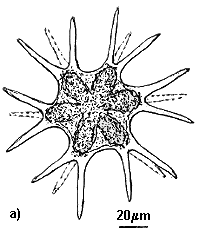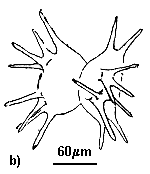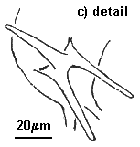A RARE FORM OF A BEAUTIFUL DESMID
by William Ells
'This beautiful desmid is a distinctly "Western type" and is more frequent
in the plankton than other situations, often occurring in abundance' West
& Carter (1923). I have only ever found a few cells of this very attractive
single celled freshwater plant. All from three sites in Sutherland, Scotland.
 The specimen figured
is Staurastrum brasiliense var. lundellii W.&.G.S.West
1896. This is usually five angled rarely six (In British waters).
The type Staurastrum brasiliense Nordst 1869, which is usually four
angled, sometimes five, and only a little more than half the size of the
variety lundellii, was not recorded from the British Isles by W.&.G.S.West
and is not in The British Check-List (1991). The above described as a variety
by West & Carter is in the list as a 'facies'. The species cannot possibly
be confused with any other ( that's how I like 'em ). All the specimens
from Scotland the five & six angled have straight spines, the
centre ones at each angle being slightly longer than figured by West &
Carter, they were out of focus in my drawing at (a) and are indicated by
dotted lines, side view (b) and detail shown at (c). Lind & Brook (1980)
show the Lake District specimen with the shorter straight centre spine,
and the two outer spines at each angle are shown slightly curved.
The specimen figured
is Staurastrum brasiliense var. lundellii W.&.G.S.West
1896. This is usually five angled rarely six (In British waters).
The type Staurastrum brasiliense Nordst 1869, which is usually four
angled, sometimes five, and only a little more than half the size of the
variety lundellii, was not recorded from the British Isles by W.&.G.S.West
and is not in The British Check-List (1991). The above described as a variety
by West & Carter is in the list as a 'facies'. The species cannot possibly
be confused with any other ( that's how I like 'em ). All the specimens
from Scotland the five & six angled have straight spines, the
centre ones at each angle being slightly longer than figured by West &
Carter, they were out of focus in my drawing at (a) and are indicated by
dotted lines, side view (b) and detail shown at (c). Lind & Brook (1980)
show the Lake District specimen with the shorter straight centre spine,
and the two outer spines at each angle are shown slightly curved.


This article first appeared in issue No.30 of Balsam Post the newsletter
of The Postal Microscopical Society (British).
When I collect or receive samples, about half the sample is preserved
the rest being examined live. I prefer examining living material, preserving
in NBS * Algae Fix No.1 & 2 will help keep desmids green, but there
is nothing like the bright often vibrant green of living specimens. Beginners
who have only seen desmids in fluid mounts on the PMS Circuit are strongly
advised to collect fresh samples from Loch, Lake and Tarn, boggy places
where sphagnum moss and the Sundew plant grows are ideal places to find
desmids.
* NBS = Northern Biological Supplies, 3 Betts Avenue, Martlesham
Heath, Ipswich IP5 7HR, England.
References:-
Brook A.J. & Williamson D.B. (1991). A Check-List of Desmids
of The British Isles. Freshwater Biological Association.
Lind E.M. & Brook A.J.(1980). Desmids of the English Lake
District. Freshwater Biological Association.
West W. & West G.S. Vol 5 by Nellie Carter 1923. A Monograph
of the British Desmidiaceae. Ray Society.
Comments and feedback can be passed on to the author Bill
Ells.
©www.microscopy-uk.net and their contributors. ®Micscape
Magazine, the official web magazine of Microscopy
UK - 'Home' of Amateur Microscopy on the Web!
WIDTH=1
© Onview.net Ltd, Microscopy-UK, and all contributors 1995 onwards. All rights
reserved. Main site is at www.microscopy-uk.org.uk with full mirror at www.microscopy-uk.net.
 The specimen figured
is Staurastrum brasiliense var. lundellii W.&.G.S.West
1896. This is usually five angled rarely six (In British waters).
The type Staurastrum brasiliense Nordst 1869, which is usually four
angled, sometimes five, and only a little more than half the size of the
variety lundellii, was not recorded from the British Isles by W.&.G.S.West
and is not in The British Check-List (1991). The above described as a variety
by West & Carter is in the list as a 'facies'. The species cannot possibly
be confused with any other ( that's how I like 'em ). All the specimens
from Scotland the five & six angled have straight spines, the
centre ones at each angle being slightly longer than figured by West &
Carter, they were out of focus in my drawing at (a) and are indicated by
dotted lines, side view (b) and detail shown at (c). Lind & Brook (1980)
show the Lake District specimen with the shorter straight centre spine,
and the two outer spines at each angle are shown slightly curved.
The specimen figured
is Staurastrum brasiliense var. lundellii W.&.G.S.West
1896. This is usually five angled rarely six (In British waters).
The type Staurastrum brasiliense Nordst 1869, which is usually four
angled, sometimes five, and only a little more than half the size of the
variety lundellii, was not recorded from the British Isles by W.&.G.S.West
and is not in The British Check-List (1991). The above described as a variety
by West & Carter is in the list as a 'facies'. The species cannot possibly
be confused with any other ( that's how I like 'em ). All the specimens
from Scotland the five & six angled have straight spines, the
centre ones at each angle being slightly longer than figured by West &
Carter, they were out of focus in my drawing at (a) and are indicated by
dotted lines, side view (b) and detail shown at (c). Lind & Brook (1980)
show the Lake District specimen with the shorter straight centre spine,
and the two outer spines at each angle are shown slightly curved.

